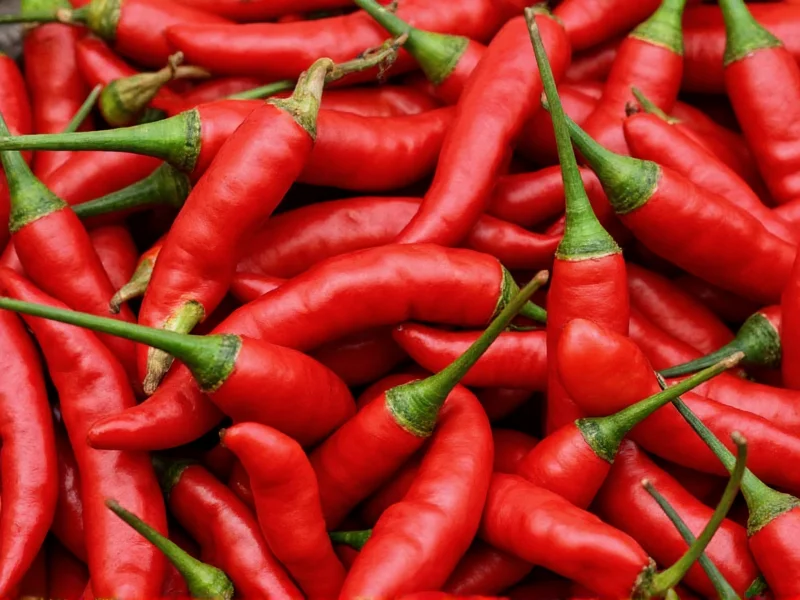Understanding the precise heat level of Thai chilis is essential for both home cooks and culinary professionals. These slender, pointed peppers—also known as bird's eye chilies or prik kee noo in Thai—pack a serious punch that can transform dishes when used correctly. Their heat intensity varies based on multiple factors including color, growing conditions, and specific variety.
Scoville Scale Measurement for Thai Chilis
The Scoville scale remains the standard measurement for chili pepper heat, quantifying capsaicin concentration in Scoville Heat Units (SHU). Thai chilis consistently register between 50,000 and 100,000 SHU, though specific measurements depend on several variables:
| Pepper Type | Scoville Heat Units | Heat Comparison |
|---|---|---|
| Thai Chili (Red or Green) | 50,000-100,000 SHU | 10-20x hotter than jalapeño |
| Jalapeño | 2,500-8,000 SHU | Baseline for medium heat |
| Habanero | 100,000-350,000 SHU | 2-7x hotter than Thai chili |
| Serrano | 10,000-23,000 SHU | 2-4x hotter than jalapeño |
| Cayenne | 30,000-50,000 SHU | Slightly milder than Thai chili |
Factors Affecting Thai Chili Heat Levels
Several elements influence the actual spiciness you'll experience when working with Thai chilis:
Color Variation
Contrary to popular belief, red Thai chilis aren't inherently hotter than green ones. Both colors come from the same plant, with red representing the fully mature stage. Heat levels remain relatively consistent across color variations, though red chilis often develop slightly sweeter, more complex flavors as they ripen.
Geographical Origin
Thai chilis grown in Thailand typically reach the higher end of the heat spectrum (75,000-100,000 SHU), while those cultivated in milder climates like California often measure closer to 50,000-70,000 SHU. Soil composition, temperature fluctuations, and water availability all contribute to these regional differences in how spicy Thai chilis can be.
Individual Plant Variation
Even on the same plant, heat levels can vary significantly between pods. Stressors like drought or nutrient deficiency often increase capsaicin production, making some chilis noticeably hotter than others from the identical plant—a crucial consideration when determining how spicy are Thai chilis in your specific batch.
Sensory Experience of Thai Chili Heat
Thai chilis deliver a distinctive heat profile that differs from other hot peppers. Unlike the slow-building burn of habaneros or the sharp sting of serranos, Thai chilis produce an immediate, intense heat that peaks quickly and subsides relatively fast. This rapid heat curve makes them ideal for dishes where you want pronounced spiciness without overwhelming lingering burn.
The heat primarily concentrates in the placenta (the white ribs inside the pepper) and seeds. The flesh itself contains minimal capsaicin, which explains why careful removal of these internal structures can dramatically reduce the overall spiciness when cooking with Thai bird chilies.
Safe Handling Practices for Thai Chilis
Working with extremely hot peppers requires proper precautions to avoid skin and eye irritation:
- Always wear disposable gloves when handling Thai chilis
- Avoid touching your face, especially eyes, during preparation
- Use separate cutting boards for hot peppers
- Wash hands thoroughly with soapy water after handling (alcohol-based sanitizers can spread capsaicin)
- Remove seeds and membranes with precision to control heat levels in recipes using Thai bird chilies
Culinary Applications and Heat Management
Thai cuisine expertly balances the intense heat of these chilis with complementary flavors. When incorporating Thai chilis into your cooking, consider these professional techniques for managing their significant spiciness:
For authentic Thai dishes like Tom Yum soup or Pad Kra Pao, whole chilis often simmer in the dish, releasing heat gradually. The spice level adjusts naturally based on cooking time—longer simmering extracts more capsaicin. Alternatively, finely chopping chilis distributes heat more evenly throughout the dish.
If you've ever wondered how spicy are red Thai chilis compared to green in cooking applications, the difference is minimal. However, red chilis contribute richer color and slightly sweeter flavor notes that work well in curries, while green chilis provide brighter, grassier notes ideal for salads and dipping sauces.
Common Misconceptions About Thai Chili Heat
Several myths persist about these potent peppers that can lead to culinary mishaps:
- Myth: The seeds contain most of the heat
Reality: Capsaicin concentrates in the placenta (white ribs), not the seeds - Myth: Milk neutralizes chili heat immediately
Reality: Dairy helps but takes 15-20 minutes to fully alleviate burning sensation - Myth: Cooking destroys capsaicin
Reality: Heat is stable up to 400°F (204°C)—cooking actually helps distribute it - Myth: All Thai chilis have identical heat levels
Reality: Significant variation occurs between plants and growing conditions
Substitutes When Thai Chilis Aren't Available
If you're unable to find authentic Thai chilis but need that distinctive heat profile, consider these alternatives with appropriate adjustments:
- Serrano peppers: Use 2-3 serranos for every Thai chili (milder heat with similar flavor profile)
- Red pepper flakes: Start with 1/4 teaspoon crushed red pepper per chili, adjusting to taste
- Habanero (carefully): Use 1/4 to 1/2 of a habanero for extreme heat with different flavor notes
- Cayenne powder: 1/8 teaspoon cayenne equals approximately one Thai chili
Remember that substitutes never perfectly replicate the unique floral notes of fresh Thai chilis, but they can provide comparable heat levels when properly measured.











 浙公网安备
33010002000092号
浙公网安备
33010002000092号 浙B2-20120091-4
浙B2-20120091-4